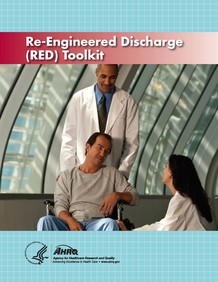| February 16, 2021, Issue #751 In 2018, the bottom 50 percent of Americans with the lowest healthcare spending accounted for only about 3 percent of total U.S. healthcare expenditures. People in this group spent an average of $384 during the year for healthcare. (AHRQ, Medical Expenditure Panel Survey Statistical Brief #533: Concentration of Healthcare Expenditures and Selected Characteristics of High Spenders, U.S. Civilian Noninstitutionalized Population, 2018.) - In recognition of American Heart Month, a new blog post by AHRQ leaders highlights agency efforts to advance heart health by synthesizing and implementing evidence to improve outcomes and reduce health inequities. Arlene S. Bierman, M.D., M.S., director of the agency's Center for Evidence and Practice Improvement, and David Meyers, M.D. AHRQ's acting director, note that the COVID-19 pandemic has presented new challenges to people living with heart disease and their healthcare providers. In response, AHRQ has revised its TAKEheart initiative to increase the use of cardiac rehabilitation among heart attack and stroke victims. Meanwhile, the agency's EvidenceNOW: Advancing Heart Health in Primary Care initiative is helping more than 1,500 small- and medium-sized primary care practices across the United States improve the heart health of millions of Americans.
- An additional blog post highlights the success of AHRQ-listed Patient Safety Organizations (PSOs) and encourages feedback on a draft report to Congress that is aimed at accelerating national efforts to keep patients safe from harm. Authors of the blog post—Jeff Brady, M.D., M.P.H., director of AHRQ's Center for Quality Improvement and Patient Safety, and Andrea Timashenka, J.D., director of AHRQ's PSO program—describe the unique role of AHRQ-listed PSOs in boosting safety and note the draft report's importance in advancing patient safety as a national priority.
 Vaccinating young children and older adults in a community against norovirus can deliver significant clinical and economic benefits, according to a new AHRQ-funded study published in the American Journal of Preventive Medicine. Vaccines are now in development against norovirus, which each year causes mild to severe gastrointestinal symptoms in about 20 million Americans. The authors developed a computational simulation model of the spread of norovirus in different age groups within the U.S. population, in order to better understand the value of vaccinating children under 5 years old and adults 65 years of age and older. They found that, depending on vaccine efficacy and modeled population coverage, vaccinating all preschool-aged children could avert up to 72 percent of symptomatic norovirus cases in a community, and vaccinating all older adults could avert up to 29 percent of such cases. Access the abstract. | AHRQ's Patient Safety Network (PSNet) highlights journal articles, books and tools related to patient safety. Articles featured this week include: Review additional new publications in PSNet's current issue or access recent cases and commentaries in AHRQ's WebM&M (Morbidity and Mortality Rounds on the Web).  Skilled nursing facilities that tested AHRQ's Re-Engineered Discharge (RED) toolkit found that training during weekly staff meetings was more effective than a single full-day course, according to a study published in Clinical Nursing Research. The RED toolkit, designed for hospitals, was tested by four skilled nursing facilities from 2013 to 2015. They used either standard implementation, which trained staff via weekly meetings, or enhanced implementation, in which staff training was completed during a single full-day course. Standard implementation facilities also had stronger leadership support for revised discharge procedures. While facilities using the enhanced implementation saw no change in rehospitalization rates, standard implementation reduced rehospitalizations by 45 percent at 30 days, 50 percent at 60 days, and 39 percent at 180 days. Access the abstract. | Registration is open for a webinar on March 3 from 1 to 2 p.m. ET focused on supporting healthcare organizations in using AHRQ's Consumer Assessment of Healthcare Providers and Systems (CAHPS®) surveys to improve patient experience. Speakers will discuss their use of different data analysis methods to better understand patients' experiences, focus improvement efforts, identify potential solutions and track the impact of interventions. This is the second webinar in a series of three presentations. | AHRQ in the Professional Literature A novel in situ simulation framework for introduction of a new technology: the 3-Act-3-Debrief model. Barker LT, Bond WF, Vincent AL, et al. Adv Simul. 2020 Sep 25;5:25. Access the abstract on PubMed®. A call for collaboration and consensus on training for endotracheal intubation in the medical intensive care unit. Brown W, Santhosh L, Brady AK, et al. Crit Care. 2020 Oct 22;24(1):621. Access the abstract on PubMed®. Criteria for intradermal skin testing and oral challenge in patients labeled as fluoroquinolone allergic. Krantz MS, Stone CA, Jr., Yu R, et al. J Allergy Clin Immunol Pract. 2021 Feb;9(2):1024-8.e3. Epub 2020 Sep 24. Access the abstract on PubMed®. Neonatal abstinence syndrome and maternal opioid-related diagnoses in the US, 2010-2017. Hirai AH, Ko JY, Owens PL, et al. JAMA. 2021 Jan 12;325(2):146-55. Access the abstract on PubMed®. Simulation to train pediatric ICU teams in endotracheal intubation of patients with COVID-19. Balikai SC, Badheka A, Casey A, et al. Pediatr Qual Saf. 2021 Jan-Feb;6(1):e373. Epub 2020 Dec 28. Access the abstract on PubMed®. Readmission and death after initial hospital discharge among patients with COVID-19 in a large multihospital system. Donnelly JP, Wang XQ, Iwashyna TJ, et al. JAMA. 2021 Jan 19;325(3):304-6. Access the abstract on PubMed®. Patient-reported outcomes collected in ambulatory oncology practices: feasibility, patterns, and correlates. Friese CR, Fauer AJ, Kuisell C, et al. Health Serv Res. 2020 Dec;55(6):966-72. Epub 2020 Oct 30. Access the abstract on PubMed®. Distinguishing high-performing health systems using a composite of publicly reported measures of ambulatory care. Agniel D, Haviland A, Shekelle P, et al. Ann Intern Med. 2020 Nov 17;173(10):791-8. Epub 2020 Sep 22. Access the abstract on PubMed®. Contact Information For comments or questions about AHRQ News Now, contact Bruce Seeman at (301) 427-1998, or Bruce.Seeman@ahrq.hhs.gov. |





No comments:
Post a Comment